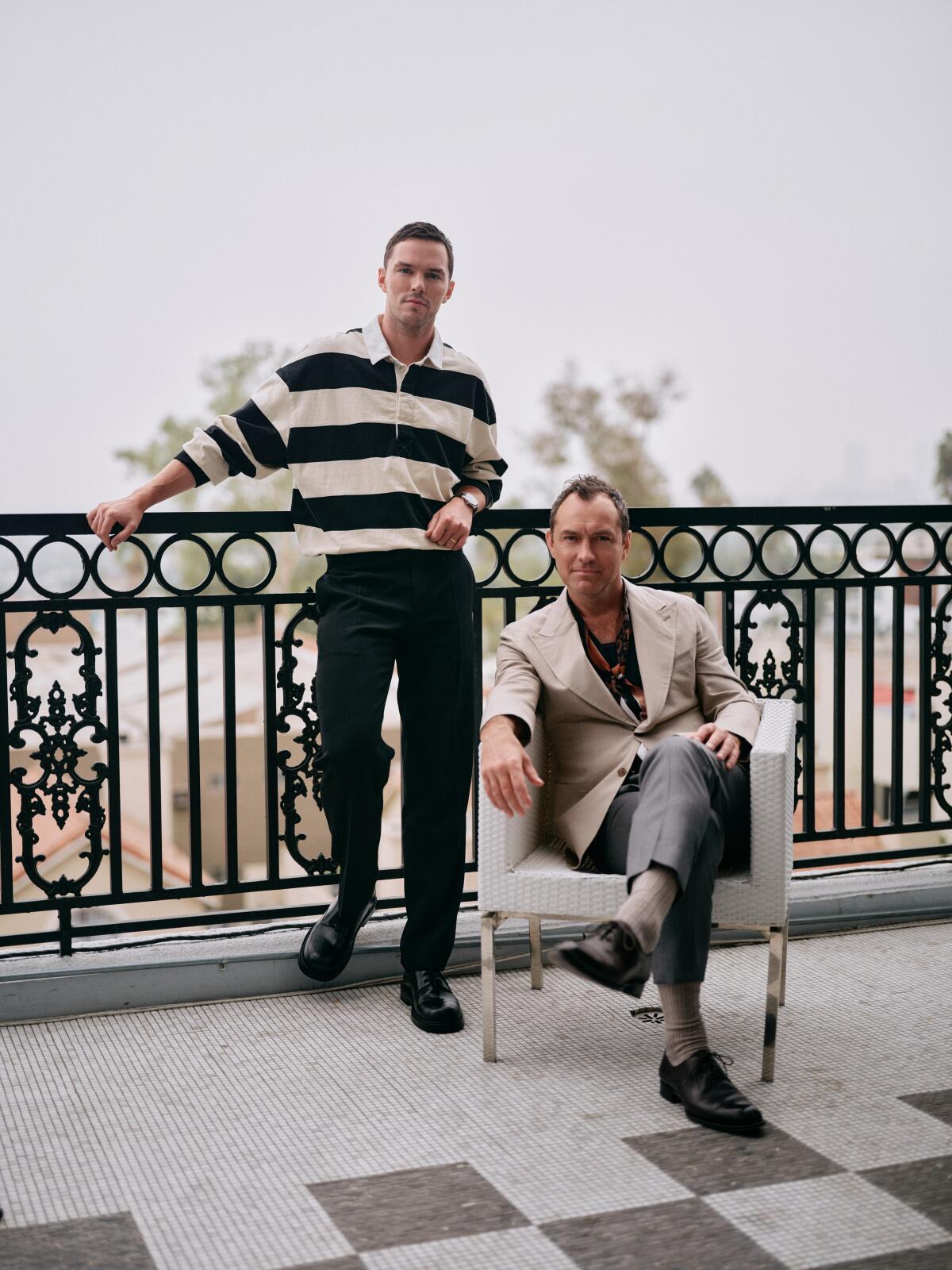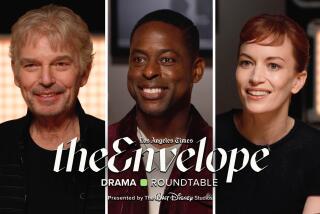Getting at the heart of American darkness, Jude Law and Nicholas Hoult go deeper than ever

- Share via
Part crime drama, part little-known chapter in the modern history of hate groups in America, “The Order” is by turns thrilling and chilling, featuring riveting performances by two actors at the absolute top of their games.
Directed by Justin Kurzel from a screenplay by Zach Baylin based on the 1989 nonfiction book “The Silent Brotherhood” (by Kevin Flynn and Gary Gerhardt), the film follows a veteran FBI agent, Terry Husk (Jude Law), on what he thinks will be a quiet assignment in the Pacific Northwest. It puts him on the trail of a rising white nationalist group and its darkly charismatic leader, Robert Jay Matthews (Nicholas Hoult).
Law and Hoult give emotionally detailed, deeply felt performances that partly work against type, while the film’s unblinking portrait of the seductive, corrosive power of hate gives it a power that rises above a typical cat-and-mouse policier.
Matthews’ real-life group, known as the Order, undertook a series of increasingly bold bank and armored-car robberies and, in its most notorious action, carried out the 1984 murder of Denver talk-radio host Alan Berg.
“It was this untold story that seemed, first of all, very important to shed light on, but also that had all these terrifying threads of relevance to today,” says Law, also a producer on the project. “It seemed exciting to be able to tell a story in the past that somehow reverberated in the present. And then folding that into a genre piece that reminded me of films I went to, real crowd-pleasers of the ’70s and ’80s that are a thrill to watch. To me, that’s a real sweet spot.”
“The Order” (in theaters Dec. 6) premiered at the Venice Film Festival in August before moving on to the Toronto International Film Festival. With a cast that also includes Jurnee Smollett, Tye Sheridan, Odessa Young and Marc Maron as radio host Berg, the movie is the first American-set project for the Australian-born Kurzel, whose previous work includes “Snowtown,” “True History of the Kelly Gang” and “Nitram,” all of which look at similarly unsettling chapters from the history of his own country.
‘I’m always interested in events that have happened in the past that are quickly labeled in a particular way,” says Kurzel, “and you revisit them and see different aspects to them or different points of view, especially dark chapters in history.
“There was something about this that did remind me a lot, especially, of my first film, ‘Snowtown,’” Kurzel says, referring to his 2011 tale of murder in a small town. “This idea of how a figure starts to exploit a community and starts to empower and build a really powerful base around them.”

Kurzel likes to give his actors what he calls “little manifestos” before shooting begins — notes that include instructions for all sorts of actions and activities to more fully consider the mindset and lifestyle of a character, such as what they do first thing after they wake up.
Hoult came to the production with only a couple days off after shooting Robert Eggers’ forthcoming “Nosferatu.” Then, after finishing “The Order,” he immediately shot a screen test for the role of Lex Luthor in the upcoming “Superman” reboot before heading right into shooting Clint Eastwood’s “Juror #2.”
In high demand, the actor recalls how he would use any downtime toward the end of shooting “Nosferatu” to send in-character voice notes to Kurzel, conscientious to switch his accent, musing on Matthews’ gun collection or his feelings about America.
Among the instructions for Law were to follow Hoult around for a day without being detected and to assemble a dossier on his activities.
“It’s hard,” Law recalls of the task. And while Law, a two-time Academy Award nominee, had never before worked with a director who asked such things of their performers before production, he came to understand the logic of it.
“I found it very rewarding,” says Law. “It’s symbolic of the kind of director he is, how he builds the relationship with the actor and ultimately the character, and how he can then use that on the set. There was such an intuitive sense between the two of us of who Husk was by the time we started to film.”

Law and Hoult are actually on-screen together for only a few fleeting moments, their main scene together being one where Matthews has followed Husk out to a lake where he is doing some recreational hunting on his off time. The two men have a brief exchange, Matthews fully aware of who Husk is, Husk unaware of who it is he is talking to.
The scene is at once riveting and frightening, with a live-wire unpredictability. Kurzel deliberately worked out the schedule so the two actors could be kept apart until that confrontation, bringing an extra charge to the moment as their characters size each other up.
“After they finished the scene, they came together, and they hugged and kind of caught up with each other,” remembers Kurzel. “But I did notice there was this sort of tension that was not only because of the characters they were playing but [also] because they hadn’t spoken to each other. There was a sort of mystery in that, where it just opened up a whole lot of questions that felt really intriguing as to what those two men in that moment felt toward each other.”
While Hoult’s character is very much based on the real Robert Matthews, Law’s character is fictional, a composite drawn from a number of FBI agents who were involved in the case, and shaped with a healthy bit of dramatic license.
As a man estranged from his family who loses himself in his work, Law portrays Husk as someone easy to underestimate, seemingly adrift in a fog of booze and self-pity, yet driven by a professionalism who can nevertheless rise to the occasion when needed.
In one scene, where Husk is angrily yelling at a younger subordinate following a harrowing, violent encounter with Matthews’ gang, Law impulsively punched the windshield from inside a car, cracking it.
“It was a lucky shot,” Law says with a dismissive smile
“It was magic working with Jude,” says Hoult, who remembers watching Law in 2001’s “A.I. Artificial Intelligence” when he was only around 12.
“He truly embodied the character in a way that I don’t see Jude at all. It made me even more of a fan of his, because obviously, growing up as a young English actor, I watched him and saw him give so many brilliant performances in his career. But now getting to watch him do this and really a surprising, different turn. I don’t think if people would’ve read the script they’d have imagined Jude in the character.”

Among the most disturbing scenes in the film is one in which Matthews galvanizes a rally of white nationalists with a speech that ends with the room chanting, “Defeat never, victory forever.” The scene was particularly challenging for Hoult, who had to convey with passionate conviction an ideology that is personally abhorrent to him.
“I remember that scene distinctly because it was the first time it felt scary,” says Hoult. “The power of it, because it felt fairly real in an odd way. There was something there where we were all a little bit shook up by that because we hadn’t done anything of that nature in the shooting until then. And all the actors in that room, everyone was very committed and brought a lot of energy. So it was suddenly something where you’re like, ‘This is kind of beyond us in a way.’”
Director Kurzel was also caught off-guard by the conjuring of that disconcerting energy on the set.
“On the day, it was very confronting,” he says. “Nick is so brave, he had to suddenly really go into a space where he had to be very convincing and he had to really reach out to this crowd. And you could feel it in the room. You sort of go, ‘Oh, I get it,’ a kind of building feeling in a group because it was really dynamic, and it felt extremely dangerous.
“Because Nick was so convincing and just so powerful in the way in which he was playing this role, you could see people were listening and engaged,” Kurzel adds. “We all looked at each other, and you get a little bit of understanding as to how people suddenly get influenced by this sort of speech.”
Matthews would die in a 1984 law-enforcement siege at a farmhouse in Washington state, and the surviving members of the Order would eventually be imprisoned. Title cards at the end of the film draw an explicit connection between the actions of Matthews and his gang and the 1995 bombing of a federal building in Oklahoma City — as well as the insurrection of Jan. 6, 2021.

Exploring two figures on opposite sides of the law drawn toward each other in the tradition of Michael Mann’s “Heat,” the creative team behind “The Order” knew they were dealing with particularly volatile material, given the divisive hatefulness of the ideology being explored.
“I really responded to: Why do people lean toward figures like Bob Matthews?” says Kurzel. “What sort of influence does he have and what are they feeling in their own lives where they are seeking out answers in such dangerous minds? A lot of that has to do with feeling not heard and feeling invisible in some way.”
“The Order” looks to bring a sense of understanding as to how a figure like Matthews can rise to prominence, while also being careful not to seem sympathetic to his despicable cause.
“It was very delicate territory to tread and particularly brave of Nick to go there,” says Law. “To bring a character like Bob Matthews to light, you have to be very careful. You are not in any way celebrating.”
“He was a toxic individual,” adds Law, “but surely the job of the film is to understand him in order to try and stop this happening again.”
More to Read
Only good movies
Get the Indie Focus newsletter, Mark Olsen's weekly guide to the world of cinema.
You may occasionally receive promotional content from the Los Angeles Times.











